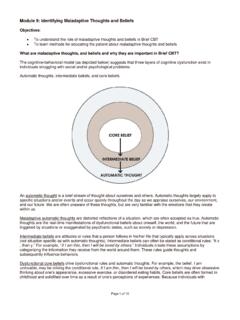Transcription of Module 4: Case Conceptualization and Treatment Planning
1 Page 1 of 6 Module 4: case Conceptualization and Treatment Planning Objectives To better understand the role of case Conceptualization in cognitive-behavioral therapy. To develop specific case Conceptualization skills, including: a) Assessing patient concerns/difficulties b) Establishing a Treatment plan (goal setting) c) Identifying Treatment obstacles What are case Conceptualization and Treatment Planning , and why are they important in Brief CBT? case Conceptualization is a framework used to 1) understand the patient and his/her current problems, 2) inform Treatment and intervention techniques and 3) serve as a foundation to assess patient change/progress. case Conceptualization also aids in establishing rapport and a sense of hope for patients. case Conceptualization is vital to effective Treatment and represents a defining characteristic of expert clinicians. Using these skills, clinicians are better able to define a Treatment plan using intervention techniques that provide the best opportunities for change.
2 This focused and informed approach provides the roadmap for both patients and therapists and should include a foundation for assessing change/progress. case Conceptualization is particularly important for short-term therapy, as it serves to focus both the patient and clinician on the salient issues so as to avoid ancillary problems that often serve as distractions to core goals. When? (Indications/Contraindications) Conceptualization should begin during the first session and become increasingly refined as Treatment progresses. An assessment of current difficulties and the creation of a problem list should occur during the first session. A Treatment plan (including Treatment goals) should be addressed early in Treatment (sessions 1, 2). Early Conceptualization and Treatment Planning may require modification as additional information becomes available. Treatment plans and goals should be routinely revisited to ensure that the patient is improving and agrees with the flow of the therapeutic work.
3 How? (Instructions/Handouts) case Conceptualization Step 1: Assessing Patient Concerns/Difficulties The patient's presenting concerns and current functioning can be assessed in a number of different ways. The following section outlines several possible avenues for identification of problems/concerns. A) Using established self-report symptom inventories. A common practice in CBT involves the use of self-report symptom measures to assess baseline functioning as well as therapeutic progress. Frequently used measures for Page 2 of 6 depression and anxiety include Beck Depression Inventory Second Edition, Patient Health Questionnaire (depression), Geriatric Depression Scale, Beck Anxiety Inventory, and the State-Trait Anxiety Inventory. Self-report measures are often completed by patients while in the waiting room and evaluated by the clinician during the session. Often self-report measures can serve as a routine agenda item during CBT sessions and can highlight important improvements and/or continuing symptoms.
4 Information obtained from these self-report inventories can also provide insight into the way the patient thinks and behaves and factors that might be important areas of need. B) Problem lists. These are a common and useful strategy for identifying the psychological, social, occupational, and financial difficulties faced by patients. Therapists who used problem lists typically elicit a list of five to 10 difficulties from the patient during the first part of session 1. Problems are best identified using open-ended questions ( , What brings you to this clinic? What issues would you like to focus on in our work together? ). Problems are best described in terms of symptom frequency (How often does the symptom occur?), intensity (How mild or severe is it?) and functional impact (What influence does the symptom have on daily functioning or general distress?). Some patients may describe their difficulties or goals in vague or abstract ways, such as, I want to improve my life, or I want to be happy again.
5 Problems and subsequent goals are best described in specific terms to maintain clinical focus. For example, specific problems are listed in the following table. Problem Frequency Severity Impact Socially Isolated Stay at home 6 out of 7 days Limited social contacts; moderate-to -severe isolation Highly distressing; socially debilitating; estranged family/friends Pain Experience pain each hour Pain intensity is high, 7 of 10, when present Pain leading to decreased activity level, inability to work Feelings of Worthlessness Occur 3 out of 7 days Very intense when present; sometimes involves suicidal thoughts Highly distressing; influences work, social, and intimate relationships Fatigue Occurs almost constantly Fatigue not intense but troublesome Decreased activity level, frequent naps, inability to complete daily tasks C) Assessing cognitions. Within the CBT model, it is often helpful to examine the patient's thoughts especially as they are perceived by the patient.
6 A commonly used, structured way to examine these factors is to assess (ask questions related to) how the patient perceives him-/herself, others, and the future. For example, a patient might describe him- or herself as incapable, not useful, or a burden. He or she may generally perceive others to be critical or hard to please. And his/her view of the future might be largely pessimistic and contain beliefs that the future will include only more losses and disappointments (see also Thought Records in Modules 9 and 10). D) Assessing behaviors and precipitating situations. Precipitating situations are events, behaviors, thoughts, or emotions that activate, trigger, or compound patient difficulties. The Antecedents, Behavior, Consequences (ABC) Model is a formalized model for examining behavior (symptoms) in a larger context. It postulates that behaviors are largely determined by antecedents (events that precede behavior/thoughts/mood) and consequences (events that follow the behavior/thoughts/mood).
7 Page 3 of 6 The ABC model (see worksheet) is used in a functional assessment. It follows the premise that behavior (B) is shaped by antecedents (A) and consequences (C). The antecedent occurs before a behavior and may be a trigger for a particular reaction in the patient. Behavior is any activity (even a thought or feeling) that the patient exhibits in response to an antecedent. Consequences are events that occur after the behavior and direct the patient to either continue or discontinue the behavior. Two kinds of consequences are examined in a functional assessment: short-term and long-term consequences. Antecedents: Antecedents, or events that occur before a behavior, typically elicit emotional and physiological responses. Antecedents may be affective (an emotion), somatic (a physiological response), behavioral (an act), or cognitive (a thought). They are also subject to contextual (situational) and relational (interpersonal) factors. For example, a patient who reports depression (behavior) may feel bad when he or she is alone at home late at night (contextual antecedent) or better when he or she is around family (relational antecedent).
8 Alternatively, he or she may feel depressed by thinking, I will always be alone (cognitive antecedent). It s important to remember that antecedents can both increase and decrease a particular behavior. To help your patient identify antecedents, teach him or her to pinpoint conditions that affect his or her behavior. Behaviors: A behavior is anything the patient does, feels, or thinks immediately following the antecedent. Each behavior that your patient displays could potentially include an affective component (feelings or moods), a somatic component (bodily sensations such as rapid heartbeat or stomachache), a behavioral component (what a patient does or doesn t do), and a cognitive component (thoughts or beliefs). Consequences: Consequences are categorized as being either positive or negative. Positive consequences increase the chances that a behavior will be repeated through the experience of something pleasant or the removal of something negative ( , do not have to do a chore).
9 Negative consequences decrease the occurrence of a behavior, either by the presence of something noxious ( , being yelled at) or the absence of something desired ( , a child being grounded from watching TV). Patients tend to repeat behaviors that result in something positive or the removal of something negative. Identifying Consequences. Similarly to identifying antecedents, when you and a patient are attempting to identify the consequences of a certain behavior, it is important to explore all components of each consequence. What were you feeling right before you did that? (Affective) What happens to you physically before this happens? Do you feel sick? (Somatic) How do you normally act right before this happens? (Behavioral) What thoughts go through your mind before this happens? (Cognitive) Where and when does this usually happen? (Contextual) Do you do this with everyone, or just when you are around certain people? (Relational) Page 4 of 6 When completing a functional assessment, both short- and long-term consequences are examined.
10 Short-term consequences tend to be behavioral reinforcers, while long-term consequences tend to be negative outcomes. In the case of addiction, the short-term consequence of using a substance is intoxication, or escape from a negative mood; the long-term consequence may be legal trouble, family problems, or a hangover. Understanding the positive and negative consequences of a behavior for a patient helps design the timing and nature of intervention. For example, in the case above, an intervention would need to follow a noxious antecedent to offset the negative mood it causes. Treating the negative mood would then decrease the need for escape through substance use. A variety of questions may be used to elucidate a short-term consequence: case Conceptualization Step 2: Clinical Hypotheses and Treatment Plan Establishing focused clinical hypotheses based upon the information obtained in case Conceptualization Step #1 serves to direct intervention options and possible Treatment techniques.




